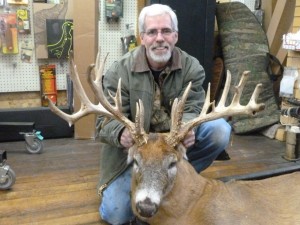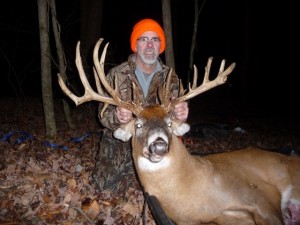Bobcats are in the news lately thanks in part to the excellent Berkshire Eagle article written on November 27 by John Sakata (Bobcats in the backyard). It featured great pictures of some cats which were taken by Raymond Jacoub. Big cat stories always grab our attention. Let me relate an old one.
It was 65 years ago (December 7, 1945) that the North Adams Transcript broke the following story about two local hunters who were reportedly chased by an animal thought to be a panther. Charles Hunt and Ruth Godfrey, both of Henderson Road, Williamstown, went hunting about 6 am in order to be in the woods for the opening hour of hunting. According to the article, while making their way through thick underbrush, and going slowly, they heard a crackling noise off to one side. Taking a position underneath a large pine tree they stood quietly awaiting developments. The crackling noise continued but seemed each time to come from a different location causing the hunters to come to the conclusion that they were being circled by some animal. The deep shadows in the forest did not permit them to make out any form, but the circling noise persisted.
Suddenly there was a blood curdling screech, which Miss Godfrey described as “making your hair stand on end and as if some woman was being horribly murdered”. This convinced the couple that the encircling animal was a member of the cat family. Again the blood curdling cry resounded through the woods, but this time much closer. At this time Miss Godfrey decided it was time to leave and she started on a run for the clearing behind her home about one-half mile away, calling to her companion to follow, which he did.
She said that she did not want to meet up with any animal that could utter such cries when she was armed with only a 410 shotgun and her fellow hunter with a 12 gauge, also when the visibility was so poor. After reaching home, they waited for full daylight when they re-entered the forest. There they found that the animal had followed them into the clearing. Tracks of the animal were as large as a man’s fist and it took 15 foot leaps. Following its traill, they learned that in running, the animal’s tail trailed in the snow.
After studying various animal books, the conclusion was reached that it must have been a panther, because of the trail signs. Miss Godfrey’s brother, James Godfrey, hunting further back in the woods that day, came across further traces of the animal where it had stalked deer.
On December 19, 1945, the Transcript reported that Charles Hunt shot the animal about 9 pm the evening before. He had trailed it from the chicken coop of his residence to the Godfrey wagon shed where a bobcat had been cornered by a dog. The bobcat weighed 31 lbs. The newspaper caption read, “Williamstown Panther is now dead bobcat”.
Nevertheless, on Saturday evening, January 26, 1946, from 8:00-8:15 pm, the couple appeared on the Sportsman’s Column of the Air, a radio show aired by WBRK in Pittsfield, where they discussed their hair-raising experience. They were interview by Attorney Frank Albright of Great Barrington, Jim Hurley, Outdoor Writer for the New York Daily Mirror, and participant of the weekly radio show Hunting & Fishing Club of the Air, and George Wiles of the Williamstown Fish & Game Protective Association. The radio show took place in the crowded auditorium of WBRK, which had a seating capacity of about 300. A number of interesting gifts were presented to them including a two-day all expense paid trip to the National Sportsman’s Show in New York City, new Trail Blazer Wrist Compasses by the Illinois Merchandise Finance Company of Pittsfield, and other items of outdoor equipment donated by local dealers. Miss Godfrey was presented a corsage. Hurley appeared in person to present the certificate for the trip to the New York Sportsman’s Show.
The couple admitted that the panther experience brought them to the realization that they were in love. Following an announcement of the couple’s upcoming marriage over the air by Mr. Wiles, they were photographed by New York, Boston, Springfield and Pittsfield papers. The Berkshire Evening Eagle featured a front page picture of the couple in its January 29, 1946 edition, with the caption “Panther Romance Pays Off”. The Transcript’s caption was, “Williamstown Panther appears employee of Cupid”.
Regardless, Wiles still felt that the animal they encountered was a panther. He claimed to have seen one after the bobcat had been killed in the same vicinity, and there were similar subsequent reports by others. Nothing like a good “ big cat” story, eh? They live forever.
Many thanks go to Lew Brown of Pittsfield for bringing this story to our attention. Lew’s father was Richard (Dick) Brown who was the Northern Berkshire Reporter for the Springfield Republican in those days. He received his information from George Wiles.
(Incidentally, the WBRK sportsman’s radio program was aired weekly and sponsored by KFC CERO-MEATO, nationally known dog food, and was conducted by Roland Mitchell.)
*****


